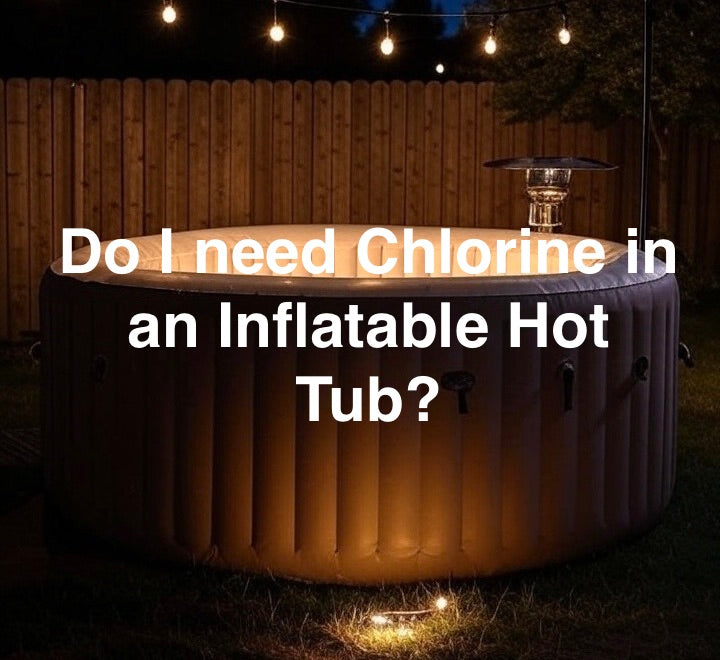
Do I Need Chlorine in an Inflatable Hot Tub?
So, you’ve got an inflatable spa bubbling away in the garden and you’re wondering: do I really need chlorine, or can I get away without it?
The short answer: yes, chlorine is the most common way to keep inflatable hot tubs clean and safe – but it’s not your only option. Stick with me, because we’ll look at alternatives, how to balance your water, and a simple routine that makes spa care stress-free.
The Short Answer: Do You Need Chlorine in an Inflatable Hot Tub?
Yes, you need a sanitiser. Without it, your spa water quickly turns into a bacteria playground – and trust me, nobody wants that.
What is a Sanitiser and Why is it Essential?
Sanitisers kill bacteria, viruses, and other nasties that thrive in warm water. Left untreated, your spa can cause skin infections, eye irritation, and even respiratory issues.
Think of it like washing your dishes. You wouldn’t eat off a plate rinsed in plain water, so why would you soak in a tub that hasn’t been sanitised?
Why Chlorine is a Popular Choice
Chlorine has been the go-to for decades. It’s cheap, easy to find, and works quickly. Drop it in, and within minutes it’s fighting off bacteria and clearing up cloudy water.
For inflatable spas, chlorine is the most straightforward option – but it isn’t perfect. That’s where alternatives come in.
Understanding Your Options: Chlorine vs. Alternatives
Chlorine: The Pros and Cons
Advantages: Quick andEffective
Chlorine works fast, especially in a busy family spa where oils, lotions, and sweat end up in the water. It’s also budget-friendly and widely available.
Disadvantages: Potential for Irritation and Odour
Some people find chlorine harsh on their skin and eyes. And yes, it has that unmistakable “public pool” smell. If you or your kids have sensitive skin, chlorine might not be the best fit.
Bromine: The Chlorine Alternative
Advantages: Stable in Heat, Gentler on Skin
Bromine is like chlorine’s calmer cousin. It’s softer on skin and eyes, and it doesn’t give off that strong smell. It also works better in higher water temperatures, which makes it great for hot tubs.
Disadvantages: Slower to Act and More Expensive
The downside? Bromine works more slowly and usually costs more. You’ll also find it in fewer shops compared to chlorine.
Other Sanitiser Options
Mineral-Based Sanitisers
Some spa owners use mineral sticks or cartridges to reduce the need for chemicals. They can help keep water clear, but you’ll usually still need a little chlorine or bromine alongside them.
Saltwater Systems (if applicable to inflatable tubs)
While saltwater systems are more common in larger, permanent hot tubs, some inflatable spas are now compatible. These systems turn salt into chlorine automatically – a neat option if you want to spend less time juggling chemicals.
Maintaining Your Water Chemistry: It’s More Than Just Chlorine
The Importance of pH and Alkalinity
What is pH and Why Does it Matter?
pH measures how acidic or alkaline your water is. Too low, and the water becomes corrosive; too high, and sanitisers stop working properly. Aim for a sweet spot between 7.2 and 7.8.
What is Total Alkalinity (TA) and its Role?
Alkalinity acts like a buffer for your pH. If it’s off, your pH will bounce around like a toddler on a trampoline. Keep it between 80–120 ppm for stability.
The Role of Hot Tub Shock
What is Shocking Your Hot Tub?
Shocking means giving your spa a stronger dose of chemicals to wipe out organic waste – things like sweat, oils, or that sunscreen you forgot to rinse off.
When and How to Shock Your Hot Tub
You’ll want to shock once a week, or after heavy use. Use either a chlorine-based shock (for a deep clean) or a non-chlorine version (gentler, faster re-entry).
Essential Hot Tub Chemicals and Tools
Chlorine Granules vs. Tablets
Granules dissolve quickly, perfect for small inflatable tubs. Tablets dissolve slowly, but they can be tricky to use in compact spas.
pH Balancers (pH Increaser and pH Reducer)
These help fine-tune your water balance, keeping it comfortable and safe.
Total Alkalinity Increaser
A must-have to stop your pH from swinging wildly.
Water Testing Strips or Kits
Your best friend for quick, accurate checks. Aim to test at least once a week – or more often if you’re using the spa daily.
Clarifiers and Foam Removers
Cloudy water or too many bubbles? These quick fixes keep your spa looking inviting.
A Simple Maintenance Routine for Your Inflatable Hot Tub

Initial Setup and Filling
When filling your spa, always start with fresh water. Add your chosen sanitiser, adjust pH and alkalinity, and let it circulate.
Daily or Pre-Use Checks
Before hopping in, check your water looks and smells clean. If in doubt, give it a quick test strip dip.
Weekly Maintenance Tasks
Test your water properly, shock the tub, and clean the filter. It only takes a few minutes but saves a lot of hassle.
When to Change the Water
Most inflatable spas need a full water change every 4–6 weeks, depending on use. If the water looks tired, smells odd, or won’t balance, it’s time for a reset.
Conclusion: The Bottom Line on Chlorine in Inflatable Hot Tubs
So, do you need chlorine in an inflatable spa? Yes – or at least some form of sanitiser.
Chlorine is quick, cheap, and effective, but bromine and other systems have their perks too. The real secret to happy spa days is balance – sanitiser, pH, and routine care. Get those right, and you’ll enjoy safe, crystal-clear soaks all year round.
Have you checked out our other posts?
Is 10 Years Old Too Young For A Hot Tub?
Can I Put Epsom Salt In My Inflatable Hot Tub?
Can You Put Pool Shock In An Inflatable Hot Tub?
Is Bromine Better Than Chlorine For Hot Tubs?
Can You Use Saltwater In An Inflatable Hot Tub?



Leave a comment